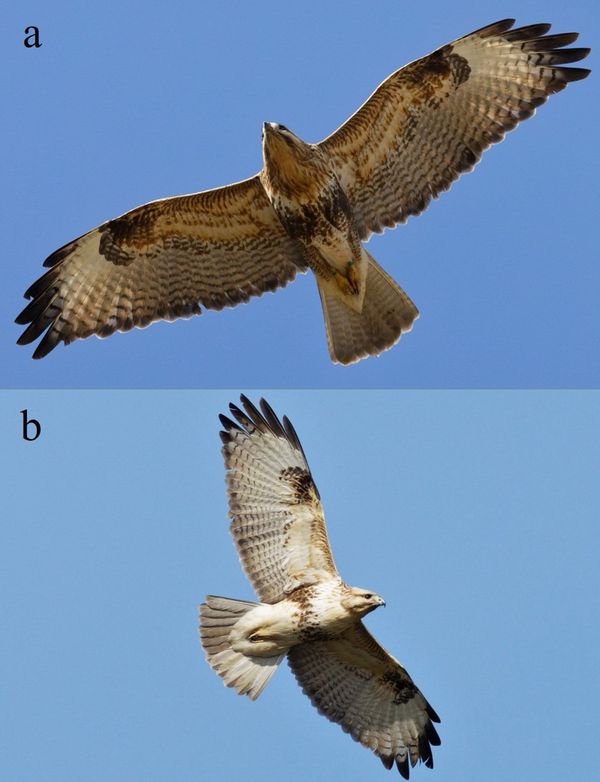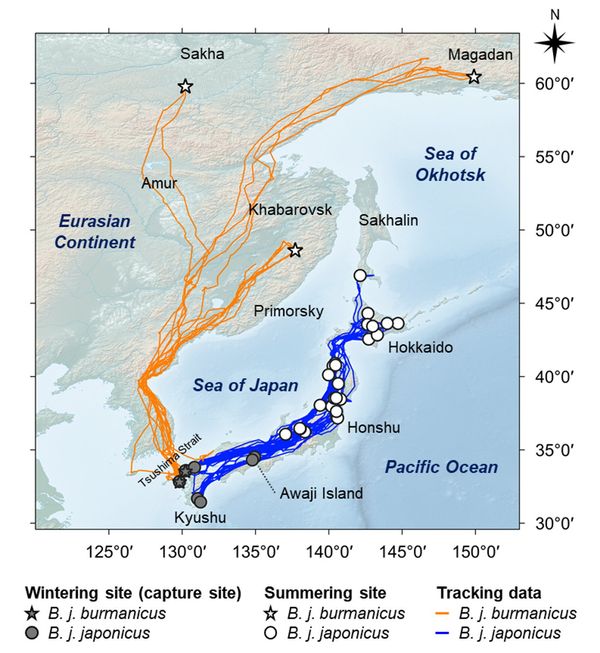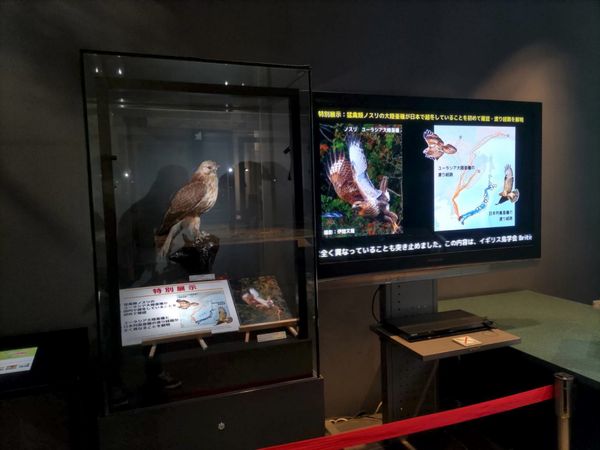 LINKED PAPER
LINKED PAPER
GPS tracking of the two subspecies of the eastern buzzard (Buteo japonicus) reveals a migratory divide along the Sea of Japan. . Nakahara, T., Nagai, K., Iseki, F., Yoshioka, T., Nakayama, F. & Yamaguchi, N.M. 2022 Ibis. doi: 10.1111/ibi.13093 VIEW
The Japanese Archipelago is separated from the Eurasian Continent by the Sea of Japan, which has kept a large semi-closed or closed water body for approximately 4.5 million years. Multiple avian lineages show a common divergence pattern between the Eurasian continent and the Japanese Archipelago across the Sea of Japan (Saitoh et al. 2010, 2015, Aoki et al. 2018). The Eastern Buzzard Buteo japonicus, living in both continental and archipelago sides of the Sea of Japan, is also one of such lineages. According to the IOC World Bird List v12.1, the continental population is regarded as a subspecies B. j. burmanicus and the population of the Japanese Archipelago is as B. j. japonicus. They are estimated to have diverged about 0.81 million years ago (Nagai et al. 2020). However, the background to their differentiation had remained unknown for a long time because their taxonomic confusion prevented researchers from comparing their distribution ranges and ecological aspects.
We captured 28 individuals of both subspecies of the Eastern Buzzard in western Japan (Kyushu and Awaji Islands) in winter and identified them based on their mitochondrial DNA sequences. We also tracked them to their breeding sites. As a result, four individuals from Kyushu were identified as B. j. burmanicus and the remaining 24 individuals were B. j. japonicus.

Figure 1 Photographs of Buteo japonicus burmanicus (a) and Buteo japonicus japonicus (b) wintering in Itoshima city, Fukuoka, Japan © Fumitaka Iseki.
Their migration routes were very different: B. j. burmanicus migrated to the Eurasian Continent crossing the Tsushima Strait and flew north along the eastern coast of the continent, whereas B. j. japonicus migrated within the Japanese Archipelago, in a broad sense (Figure 2). The former reached the Russian Far East (Sakha, Khabarovsk, and Magadan), one of which moved over 4,200 km from the wintering site in Kyushu. On the other hand, the latter reached eastern Japan (Hokkaido and north-eastern Honshu) and Sakhalin. Their routes and breeding ranges were completely separated by the Sea of Japan. This fact suggests that the Sea of Japan serves as a ‘migratory divide’ and now acts as a barrier to their gene flow.

Figure 2 Migration routes of the two subspecies of the Eastern Buzzard.
The Eastern Buzzard is a soaring raptor, which generally uses thermals for flight. Such raptors often avoid crossing a large, cold-water body as much as possible because of the weakness or absence of sea thermals (Nourani and Yamaguchi 2017). The Sea of Japan must have kept its large, cold-water body before the differentiation of the two subspecies of the Eastern Buzzard. Therefore, this sea area acts as a geographic barrier to movements of this species for a long time and is likely to contribute to the separation of migration routes between B. j. burmanicus and B. j. japonicus, although only the Tsushima Strait does not act as a complete barrier to the movement of B. j. burmanicus.
We did not find any overlap in the breeding ranges of B. j. burmanicus and B. j. japonicus. Latitudinal transitions of the breeding range of their common ancestor with climatic oscillation in the Pleistocene might have caused segregation of its population and differentiation into B. j. burmanicus and B. j. japonicus on each side, driving the endemism of B. j. japonicus in the Japanese Archipelago. To verify this, further estimation of past distribution ranges of both subspecies is needed.
Public outreach at the museum
Our finding that B. j. burmanicus wintered in Japan is some news among Japanese birders. Prior to our research, a Japanese birdwatching magazine and field guides reported on the ‘strange’ buzzard observed in western Japan which has a deeper colour, but it had not been unmasked then. Our study clarified for the first time that the ‘strange’ buzzard is B. j. burmanicus and it migrated from the Eurasian Continent. So, I exhibited the results of this study with a specimen, photos, and movies at the Kitakyushu Museum of Natural History and Human History for five weeks. I hope that not only birders but also many citizens get a chance to know our discovery about the natural history of the Eastern Buzzard.

Figure 3 Special exhibition of our research results at Kitakyushu Museum of Natural History and Human History.
Seeking information about buzzards living in the Eurasian Continent
We can get much information about the Eastern Buzzard living in Japan, but it is difficult to know about buzzards living in other countries. Taxonomic confusion between the Eastern Buzzard and Himalayan Buzzard remain and should be resolved. Our research group is interested in the classification of these (sub)species, the boundary of their distribution ranges, and the evolutionary background of their differentiation. We welcome the information on these species living in the far east region from the Sino-Himalayan mountains to the eastern coast of the Eurasian Continent.
References
Aoki, D., Kinoshita, G., Kryukov, A.P., Nishiumi, I., Lee, S.-I. & Suzuki, H. 2018. Quaternary-related genetic differentiation and parallel population dynamics of the Eurasian jay (Garrulus glandarius) in the circum-Japan Sea region. Journal of Ornithology 159: 1087-1097. VIEW
Hijikata, N., Yamaguchi, N.M., Hiraoka, E., Nakayama, F., Uchida, K., Tokita, K. & Higuchi, H. 2022. Satellite tracking of migration routes of the eastern buzzard (Buteo japonicus) in Japan through Sakhalin. Zoological Science 39: 176-185. VIEW
Irwin, D.E. & Irwin, J.H. 2005. Siberian migratory divides: The role of seasonal migration in speciation. In Greenberg, R. & Marra, P.P. (eds) Birds of Two Worlds: The Ecology and Evolution of Migration. 27–40. Baltimore: Johns Hopkins University Press.
James, A.H. 1988. Geographic variation in the buzzard Buteo buteo (L.): Japonicus-group (Aves: Accipitridae). Beaufortia 38: 57-74 VIEW
Nagai, K., Tokita, K.-I. & Nakayama, F. 2020. Discovery of a novel mtDNA sequence in the eastern buzzard (Buteo japonicus) in Japan. Journal of Raptor Research 54: 287-294. VIEW
Nourani, E. & Yamaguchi, N.M. 2017. The effects of atmospheric currents on the migratory behavior of soaring birds: a review. Ornithological Science 16: 5-15. VIEW
Saitoh, T., Sugita, N., Someya, S., Iwami, Y., Kobayashi, S., Kamigaichi, H., Higuchi, A., Asai, S., Yamamoto, Y. & Nishiumi, I. 2015. DNA barcoding reveals 24 distinct lineages as cryptic bird species candidates in and around the Japanese archipelago. Molecular Ecology Resources 15: 177-186 VIEW
Saitoh, T., Alström, P., Nishiumi, I., Shigeta, Y., Williams, D., Olsson, U. & Ueda, K. 2010. Old divergences in a boreal bird supports long-term survival through the ice ages. BMC Evolutionary Biology 10: 35. VIEW
Image credit
Top right: Eurasian Continental subspecies of the Eastern Buzzard Buteo japonicus burmanicus © Fumitaka Iseki.
If you want to write about your research in #theBOUblog, then please see here.




